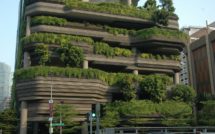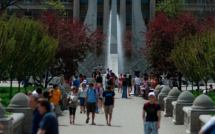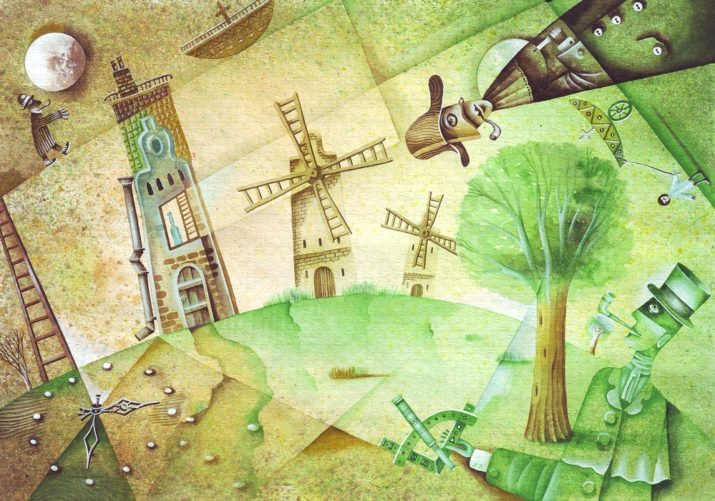
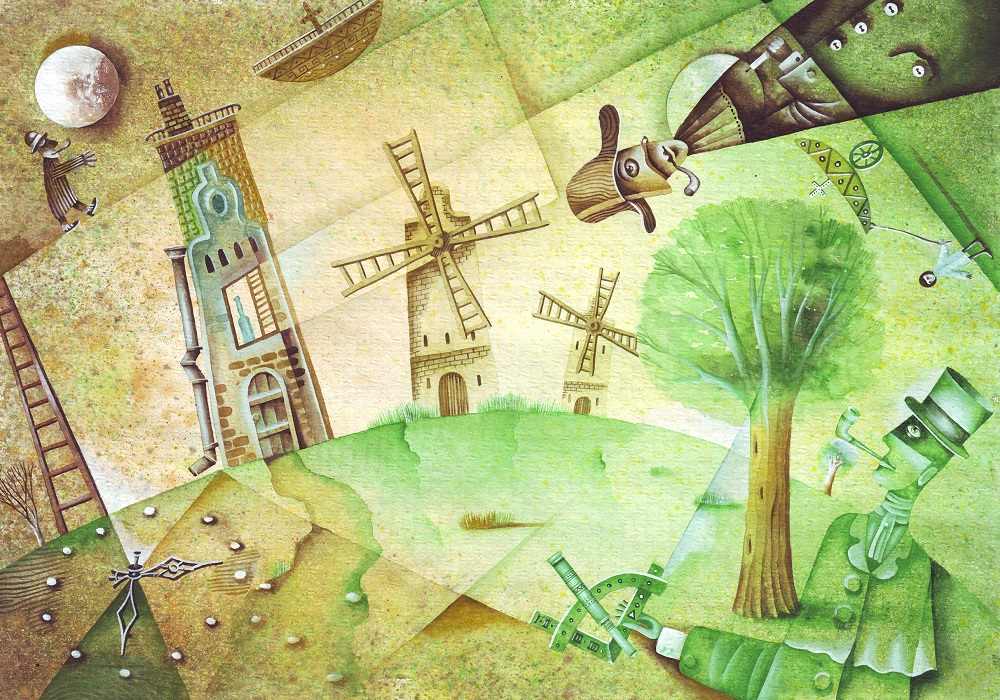
An introduction to our feature Sustainability & Innovation.
In this challenging time of governmental retrenchment—with its accompanying cuts to the Arts and Humanities—many foundations have been stepping up and pivoting their missions to a defense of democratic values and shared cultural heritages. At the same time, institutions of higher learning, think tanks, artists, policy makers, and NGOs have been reimagining their mission and innovating new models of collaboration not only among like-minded institutions, but across disciplines and national boundaries.
Many of the projects featured in this edition of EuropeNow have benefited from funding that supports innovative approaches of creating synergies between likely and formerly unlikely partners. Focusing on collaborative projects, the challenges of sustainability and innovation are addressed from various angles and disciplines via a funnel-shaped lens. The edition starts out with broad innovative environmental and urban planning initiatives and their positive impacts on city dwellers. Increasingly, urban communities stress the need to rely on renewable resources to eliminate pollution and foster social empowerment. They are innovating new models to connect urban spaces to nature and the natural world to locate urban life within nature, and not apart from it. Through successful implementation, city-wide and city-regional efficiency programs and alliances not only help sustain our planet, but also help to ensure the physical and mental well-being of its inhabitants. The design and art projects discussed in this edition take these commitments to sustainability and collaboration to concrete locales, even as they roam across national boundaries. They highlight art projects employed in refugee camps, or enacted through text and movement in military installations, or art that brings into conversation active military personnel/veterans and civilians to build bridges and make comprehensible what cannot always be expressed verbally. The locally focused architectural design projects from Queens, NY and Dessau, Germany show the way of how collaboration and commitments to sustainability can also act as catalysts for new community dialogues and novel alliances that lead to shared cultural and human experiences, and can also generate new knowledge.
Preserving shared cultural and human experiences, as well as fostering new connections are also key missions of academic communities. An example of symmetrical innovation and collaboration is the EUCOR campus, a European University made up of an alliance of five universities across three European countries with one great mission: namely to foster research innovation across disciplines and regions while also expanding professional opportunities for both researchers and students. In the U.S., with its more diverse higher educational structure, scholars and teachers are also forging ahead to rethink existing models of how to engage students and how to connect them with the wider world they live in. Our contributors have provided some inspiring examples, and the Mellon Foundation, in particular, has been at the forefront of supporting new models of such collaboration as part of its mission to “promote, and, where necessary, defend the contributions of the humanities and the arts to flourishing and to the well-being of diverse and democratic societies.” A key insight that we might take away from this edition of EuropeNow is that we need both symmetrical models such as EUCOR, but also more asymmetrical collaborations, for example, between research universities and liberal arts colleges, or between those kinds of institutions and local community colleges to bring about more diversity as well as greater understanding and empathy.
As two of our contributions illustrate, the worldwide and unprecedented “crisis” of forced migration and displacement offers an opportunity for curricular innovation and new models of social engagement. Bard College Berlin’s Program in International Education and Social Change (PIE-SC), provides college-aged refugees with scholarships (made possible by generous private donors) to continue their education, but just as importantly, it is in their developing migration curriculum that Merkel’s famous words “Wir schaffen das,” are brought to fruition. Bard Berlin has always imagined the city itself as a classroom, and, in the class described here, the students are not only brought into the heart of the city, but the city provides a new “archive” to create non-traditional research projects. Employing gallery spaces and cultural memory spaces in a city driven by, and even obsessed with memory, as well as everyday elements of city life (such as trolley cars), students, for example, re-conceptualized their assignment as “soundscapes” of a terrain still foreign to them yet slowly becoming familiar.
A student’s perspective on the collaborative projects of Vassar Refugee Solidarity and the Mid-Hudson Refugee Solidary Alliance illustrates succinctly what benefits can be gained when we are willing to think outside the box. Here we find not only collaboration between unlikely academic institutions, but also between colleges and local congregations and social service agencies, collaboration between students and tech companies, and even new ways to engage students and alums looking together for solutions to seemingly intractable challenges.
Needless to say, the key to all of these sorts of innovative programs is the mastery of foreign languages to bridge cultural divides, and also of languages that are not necessarily taught at all European and U.S. institutions of higher learning. The two language learning consortia models presented in EuropeNow discuss the curricular and administrative challenges to implement a course sharing initiative for less commonly taught languages. But they also make a strong case for the replicability and adaptability of their model beyond the “at risk” language programs (because of budgetary restraints or low enrollments numbers). Through initiatives like course sharing, the academy can foster a culture of cooperation instead of competition, and in the process can model the academy’s liberal arts commitment as new models of social-justice engaged learning.
When we engage our students with global challenges, we also allow ourselves and them to discover how intricately global challenges are interconnected with our own locales and our own lives. Greater diversity, the generation of new knowledge, and more enduring forms of integration and empathy are also generated in the collaborative models featured here. In order to achieve these lofty goals, however, the contributors to this edition suggest that our intellectual endeavors need to be more cooperative and less competitive. For such a culture to thrive fully, institutions of higher learning themselves must question their value and reward systems, which are currently based on competition and single-authored monographs or articles in peer-reviewed journals. Will institutions rigidly demarcated by disciplines and departments nurture the kind of thinking it takes to develop these sorts of innovative new models, not only within their own institutions, but beyond their own walls? The curricular and artistic innovations presented here, as well as Binghamton University’s Campus contribution, might give educators and administrators pause to think.
Urban Innovation
Research
– “The Vision and Practice of Biophilic Cities” by Timothy Beatley
– “Actually, Architecture Can Play Well With Others” by Tobias Armborst
– “Encircling the Now” by Felix Meyer-Christian
Visual Art
– Performative Polyphonies, an art series curated by Felix Meyer-Christian
Camp(us) Sustainability
Visual Art
– From the Power of Colors to Empowered Communities: Refugee Camp Transformations, an art series curated by Nicole Shea
Interview
– “‘Five Voices, Three Countries, One Goal:’ An Interview with Hans-Jochen Schiewer” by Nicole Shea
Commentary
– “Collaboration in Refugee Education: Field Notes from Bard College Berlin” by Kerry Bystrom with Marion Detjen
Research
– “From Collaboration to Strategic Coordination: Creating LCTL Partnerships Across the Big 10 Academic Alliance” by Christopher P. Long, Susan Gass, and Koen Van Gorp
– “From Interinstitutional Competition to Interinstitutional Collaboration” by Stéphane Charitos, Christopher Kaiser, and Nelleke Van Deusen-Scholl
Campus
– “The Vassar Refugee Solidarity Initiative” by Anish Kanoria
– “A Different Doctor: Reimagining the Humanities PhD for a Changing World” by Kevin Boettcher
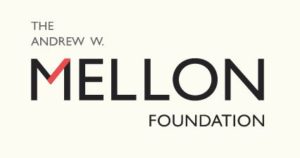
Nicole Shea is the Director of the Council for European Studies and Executive Editor of EuropeNow.
Maria Höhn is the Marion Musser Lloyd ’32 Professor of History at Vassar College. Her book GIs and Fräuleins (University of North Carolina Press, 2002) was the first book to address the experiences of African American soldiers in Germany. A Chinese translation of this book is forthcoming in 2017. She co-authored and co-edited Over There: Living with the U.S. Military Empire from World War II to the Present (Duke University Press, 2010). A Korean translation of that book will be out in early 2017. Together with a group of Vassar students, she founded Vassar Refugee Solidarity and the Mid-Hudson Refugee Solidarity Alliance.
Photo: Mill Dream Scape Illustration, Eugene Ivanov | Shutterstock
Published on June 6, 2017.

